【论文笔记】R-CNN系列之代码实现
代码源码
前情回顾:【论文笔记】R-CNN系列之论文理解
整体架构

由三部分组成
(1)提取特征的卷积网络extractor
(2)输入特征获得建议框rois的rpn网络
(3)传入rois和特征图,获得分类结果和回归结果的分类网络classifier

伪代码:
class FasterRCNN(nn.Module): def __init__(self, ...): super(FasterRCNN, self).__init__() # 构建特征提取网络 self.extractor, classifier = decom_vgg16(...) # 构建建议框网络 self.rpn = RegionProposalNetwork(...) # 构建分类器网络 self.head = VGG16RoIHead(..., classifier=classifier) def forward(self, x, scale=1.): # 计算输入图片的大小 img_size = x.shape[2:] # 利用主干网络提取特征 base_feature = self.extractor.forward(x) # 获得建议框 _, _, rois, roi_indices, _ = self.rpn.forward(base_feature, img_size, scale) # 获得classifier的分类结果和回归结果 roi_cls_locs, roi_scores = self.head.forward(base_feature, rois, roi_indices, img_size) return roi_cls_locs, roi_scores, rois, roi_indices def freeze_bn(self): for m in self.modules(): if isinstance(m, nn.BatchNorm2d): m.eval()
1.卷积网络提取特征
1.1 关于VGG16
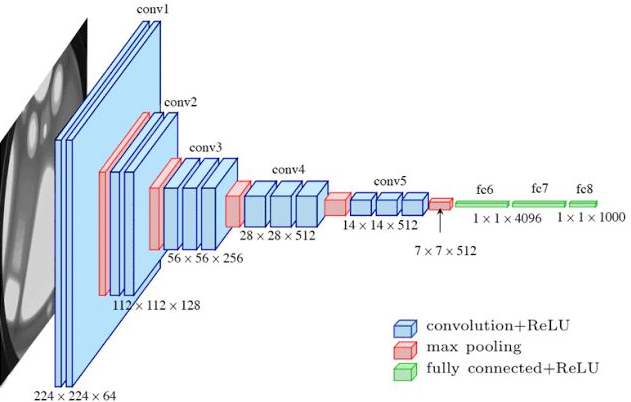
代码
import torch import torch.nn as nn cfg = [64, 64, 'M', 128, 128, 'M', 256, 256, 256, 'M', 512, 512, 512, 'M', 512, 512, 512, 'M'] '''
假设输入图像为(600, 600, 3),随着cfg的循环,特征层变化如下:
600,600,3 -> 600,600,64 -> 600,600,64 -> 300,300,64 -> 300,300,128 -> 300,300,128 -> 150,150,128 -> 150,150,256 -> 150,150,256 -> 150,150,256
-> 75,75,256 -> 75,75,512 -> 75,75,512 -> 75,75,512 -> 37,37,512 -> 37,37,512 -> 37,37,512 -> 37,37,512
到cfg结束,我们获得了一个37,37,512的特征层 ''' class VGG16(nn.Module): def __init__(self): super(VGG16, self).__init__() self.feature = make_layers(cfg, batch_norm=False) self.avgpool = nn.AdaptiveAvgPool2d((7, 7)) #不管cfg結束后特征层大小是多少,统一变成7*7 self.classifier = nn.Sequential( nn.Linear(7 * 7 * 512, out_features=4096, bias=False), nn.ReLU(inplace=True), # 原地操作更加节省内存 nn.Linear(in_features=4096, out_features=4096, bias=False), nn.ReLU(inplace=True), nn.Linear(in_features=4096, out_features=1000, bias=False), ) def forward(self, x): x = self.feature(x) x = self.avgpool(x) x = torch.flatten(x, 1) x = self.classifier(x) return x def make_layers(cfg, batch_norm=False): input_channels = 3 layers = [] for v in cfg: if v == 'M': layers.append(nn.MaxPool2d(kernel_size=2, stride=2)) else: conv2d = nn.Conv2d(in_channels=input_channels, out_channels=v, kernel_size=3, stride=1, padding=1) if batch_norm: layers += [conv2d, nn.BatchNorm2d(v), nn.ReLU(inplace=True)] else: layers += [conv2d, nn.ReLU(inplace=True)] # layers.append()不能加list input_channels = v return nn.Sequential(*layers) input = torch.randn(1, 3, 600, 600) model = VGG16() output = model(input) print(output.shape)
1.2 调整VGG16
- 利用VGG16的特征提取部分作为Faster R-CNN的特征提取网络
- 利用后半部分的全连接网络作为Faster R-CNN的分类网络
def decom_vgg16(pretrained = False): model = VGG16() feature = list(model.feature) #转化为list classifier = list(model.classifier) del classifier[-1] # 删去最后的全连接层,如果有dropout层也删掉 feature = nn.Sequential(*feature) # 再转为Sequential classifier = nn.Sequential(*classifier) return feature,classifier
打印一下classifier :

2. RPN生成区域提议
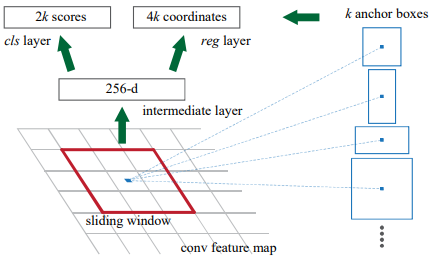
图中的intermediate layer可以用3*3的卷积实现,cls layer和reg layer都可以用1*1的卷积实现。
self.conv1 = nn.Conv2d(in_channels, mid_channels, 3, 1, 1) self.score = nn.Conv2d(mid_channels, n_anchor * 2, 1, 1, 0) self.loc = nn.Conv2d(mid_channels, n_anchor * 4, 1, 1, 0)
cls layer后接softmax层
reg layer后接筛选层
2.1 anchor
(1)计算出3*3滑动窗口中心点对应原始图像上的中心点
特征图上所有的点,对应原图上固定间隔的点
import matplotlib.pyplot as plt import numpy as np if __name__ == "__main__": width = 38 height = 38 feat_stride = 16 x = np.arange(0, width * feat_stride, feat_stride) y = np.arange(0, height * feat_stride, feat_stride) X, Y = np.meshgrid(x, y) plt.plot(X, Y, color='limegreen', # 设置颜色为limegreen marker='.', # 设置点类型为圆点 linestyle='') # 设置线型为空,也即没有线连接点 plt.grid(True) plt.show()
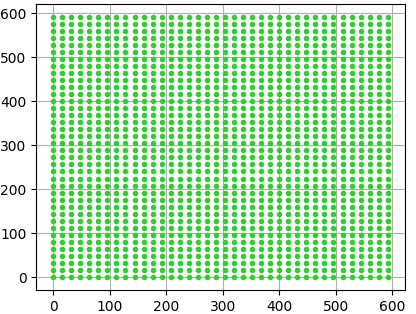
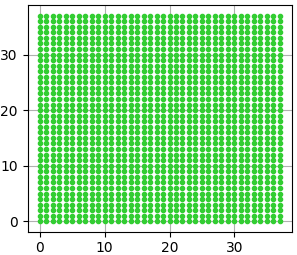
原图 特征图
(2)生成anchor box
首先在原图(0,0)位置生成一组(9个)anchor box,然后在原图上滑动(stride=16),得到(38*38*9个)anchor box
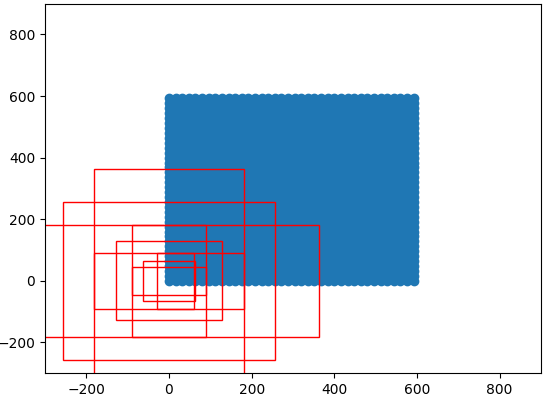
# 生成基础的9个先验框 def generate_anchor_base(base_size=16, ratios=[0.5, 1, 2], anchor_scales=[8, 16, 32]): anchor_base = np.zeros((len(ratios) * len(anchor_scales), 4), dtype=np.float32) for i in range(len(ratios)): for j in range(len(anchor_scales)): h = base_size * anchor_scales[j] * np.sqrt(ratios[i]) w = base_size * anchor_scales[j] * np.sqrt(1. / ratios[i]) index = i * len(anchor_scales) + j anchor_base[index, 0] = - h / 2. #框的四个参数分别是左上的(x,y)右下的(x,y) anchor_base[index, 1] = - w / 2. anchor_base[index, 2] = h / 2. anchor_base[index, 3] = w / 2. return anchor_base # 对基础先验框移动对应到所有特征点上(特征点在特征图上是相连的,但对应到原图上间隔feat_stride) def _enumerate_shifted_anchor(anchor_base, feat_stride, height, width): # 计算网格中心点 shift_x = np.arange(0, width * feat_stride, feat_stride) shift_y = np.arange(0, height * feat_stride, feat_stride) shift_x, shift_y = np.meshgrid(shift_x, shift_y) shift = np.stack((shift_x.ravel(), shift_y.ravel(), shift_x.ravel(), shift_y.ravel(),), axis=1) # 每个网格点上的9个先验框 A = anchor_base.shape[0] K = shift.shape[0] anchor = anchor_base.reshape((1, A, 4)) + shift.reshape((K, 1, 4))#应为anchor_base的四个参数都是坐标,所以都要平移 anchor = anchor.reshape((K * A, 4)).astype(np.float32)# 所有的先验框 return anchor # 38*38*9个
(3)获得预测框
根据rpn得到的k个(dx,dy,dw,dh),以及上一步得到的k个anchor box的位置(Px,Py,Pw,Ph),可以计算得到预测框的G(Gx,Gy,Gw,Gh)
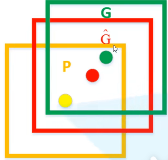
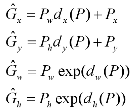
def loc2bbox(src_bbox, loc): if src_bbox.size()[0] == 0: return torch.zeros((0, 4), dtype=loc.dtype) # src_bbox就是anchor,四个参数为左上角的坐标和右下角的,所以要转换得到(Px,Py,Pw,Ph) src_width = torch.unsqueeze(src_bbox[:, 2] - src_bbox[:, 0], -1) src_height = torch.unsqueeze(src_bbox[:, 3] - src_bbox[:, 1], -1) src_ctr_x = torch.unsqueeze(src_bbox[:, 0], -1) + 0.5 * src_width src_ctr_y = torch.unsqueeze(src_bbox[:, 1], -1) + 0.5 * src_height # rpn得到的回归参数 dx = loc[:, 0::4] dy = loc[:, 1::4] dw = loc[:, 2::4] dh = loc[:, 3::4] # 计算得到预测框的G(Gx,Gy,Gw,Gh) ctr_x = dx * src_width + src_ctr_x ctr_y = dy * src_height + src_ctr_y w = torch.exp(dw) * src_width h = torch.exp(dh) * src_height # dst_bbox又是左上角右下角格式 dst_bbox = torch.zeros_like(loc) dst_bbox[:, 0::4] = ctr_x - 0.5 * w dst_bbox[:, 1::4] = ctr_y - 0.5 * h dst_bbox[:, 2::4] = ctr_x + 0.5 * w dst_bbox[:, 3::4] = ctr_y + 0.5 * h return dst_bbox
(4)筛选anchor
# 建议框筛选 (1)出界的不要 roi[:, [0, 2]] = torch.clamp(roi[:, [0, 2]], min=0, max=img_size[1]) roi[:, [1, 3]] = torch.clamp(roi[:, [1, 3]], min=0, max=img_size[0]) # 建议框筛选(2)小于16的不要 min_size = self.min_size * scale keep = torch.where(((roi[:, 2] - roi[:, 0]) >= min_size) & ((roi[:, 3] - roi[:, 1]) >= min_size))[0] roi = roi[keep, :] score = score[keep] # 建议框筛选(3)按概率选出前n_pre_nms个 order = torch.argsort(score, descending=True) if n_pre_nms > 0: order = order[:n_pre_nms] roi = roi[order, :] score = score[order] # 建议框筛选(4)利用nms选出n_post_nms个 keep = nms(roi, score, self.nms_iou) keep = keep[:n_post_nms] roi = roi[keep]
3.分类网络
分类网络主要分为三部分
(1)ROI pooling layer:将rois转换为固定大小
(2)classifier:VGG16的后半部分全连接层
(3)cls layer 和 loc layer:两个全连接层
伪代码:
class VGG16RoIHead(nn.Module): def __init__(self, n_class, roi_size, spatial_scale, classifier): super(VGG16RoIHead, self).__init__() self.roi = RoIPool((roi_size, roi_size), spatial_scale) self.classifier = classifier self.cls_loc = nn.Linear(4096, n_class * 4) self.score = nn.Linear(4096, n_class) def forward(self, x, rois, roi_indices, img_size): ... # (1) ROI pooling layer pool = self.roi(x, indices_and_rois) pool = pool.view(pool.size(0), -1) # (2) classifier layer fc7 = self.classifier(pool) # (3) cls layer 和 loc layer roi_cls_locs = self.cls_loc(fc7) roi_scores = self.score(fc7) roi_cls_locs = roi_cls_locs.view(n, -1, roi_cls_locs.size(1)) roi_scores = roi_scores.view(n, -1, roi_scores.size(1)) return roi_cls_locs, roi_scores
3. 1 ROI pooling layer

将区域提议对应的feature map转换成小的固定大小(H*W)的feature map,不限制输入map的尺寸。
ROI pooling layer的输入有两项:
(1)提取特征的网络的最后一个feature map;
(2)一个表示图片中所有ROI的N*5的矩阵,其中N表示 ROI的数目,5表示图像index和坐标参数(x,y,h,w) 。坐标的参考系不是针对feature map这张图的,而是针对原图的。
... self.roi = RoIPool((roi_size, roi_size), spatial_scale) ... pool = self.roi(x, indices_and_rois)# 利用建议框对公用特征层进行截取
(roi_size, roi_size):执行裁剪后的输出大小(int或Tuple[int,int]),如(高度、宽度)
spatial_scale:将输入坐标映射到框坐标的比例因子。默认值:1.0。
4. 训练
分为几步:
(1)获取公用特征层
(2)利用rpn网络获得调整参数、得分、建议框、先验框
(3)计算损失
4.1 计算建议框网络rpn的回归损失和分类损失
(0)rpn后我们得到rpn_locs, rpn_scores, rois, roi_indices, anchor,其中anchor是先验框,roi是预测框。
(1)为每个先验框anchor找到对应的最大IOU的真实框
def _calc_ious(self, anchor, bbox):
# 获得的ious的shape为[num_anchors, num_gt]
ious = bbox_iou(anchor, bbox)
if len(bbox)==0:
return np.zeros(len(anchor), np.int32), np.zeros(len(anchor)), np.zeros(len(bbox))
# 获得每一个先验框最对应的真实框 [num_anchors, ]
argmax_ious = ious.argmax(axis=1)
# 找出每一个先验框最对应的真实框的iou [num_anchors, ]
max_ious = np.max(ious, axis=1)
# 获得每一个真实框最对应的先验框 [num_gt, ]
gt_argmax_ious = ious.argmax(axis=0)
# 保证每一个真实框都存在对应的先验框
for i in range(len(gt_argmax_ious)):
argmax_ious[gt_argmax_ious[i]] = i
return argmax_ious, max_ious, gt_argmax_ious
# argmax_ious为每个先验框对应的最大的真实框的序号 [num_anchors, ]
# max_ious为每个真实框对应的最大的真实框的iou [num_anchors, ]
# gt_argmax_ious为每一个真实框对应的最大的先验框的序号 [num_gt, ]
(2)采样256个anchor计算损失函数,正负样本比为1:1,如果正样本少于128个,用负样本填充。每个ground truth至少对应一个先验框。
我们分配正标签前景给两类anchor:
1)与某个ground truth有最高的IoU重叠的anchor(也许不到0.7)
2)与任意ground truth有大于0.7的IoU交叠的anchor。
我们分配负标签(背景)给与所有ground truth的IoU比率都低于0.3的anchor。
(3)根据每一个先验框最对应的真实框,得到256个真实框bbox的loc gt_rpn_loc =(dx,dy,dw,dh)
(4)由rpn网络得到的rpn_loc,rpn_score和真实框得到的gt_rpn_loc,gt_rpn_label计算损失
rpn_loc_loss = self._fast_rcnn_loc_loss(rpn_loc, gt_rpn_loc, gt_rpn_label, self.rpn_sigma) rpn_cls_loss = F.cross_entropy(rpn_score, gt_rpn_label, ignore_index=-1)
4.2 计算Classifier网络的回归损失和分类损失
(0)rpn后我们得到rpn_locs, rpn_scores, rois, roi_indices, anchor,其中anchor是先验框,roi是预测框。
(1)获得每一个建议框roi最对应的真实框
(2)采样n_sample个建议框roi计算损失函数
满足建议框和真实框重合程度大于neg_iou_thresh_high的作为正样本
将正样本的数量限制在self.pos_roi_per_image以内满足建议框和真实框重合程度小于neg_iou_thresh_high大于neg_iou_thresh_low作为负样本
将正样本的数量和负样本的数量的总和固定成self.n_sample
(3)得到真实框bbox的loc gt_roi_loc =(dx,dy,dw,dh)
(4)由Classifier网络得到的roi_loc,roi_score,和真实框得到的gt_roi_loc,gt_roi_label计算损失
roi_loc_loss = self._fast_rcnn_loc_loss(roi_loc, gt_roi_loc, gt_roi_label.data, self.roi_sigma)
roi_cls_loss = nn.CrossEntropyLoss(roi_score[0], gt_roi_label)
Tip:
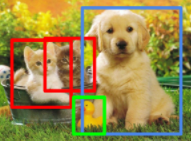
上图为4个真实框ground truth,在rpn层中,我们将roi筛选至n_post_nms个(600个)。
在rpn计算的是先验框anchor和真实框bbox的IOU,分类层用的是建议框roi和真实框bbox的IOU
5. 评价指标
5.1计算交并比IOU
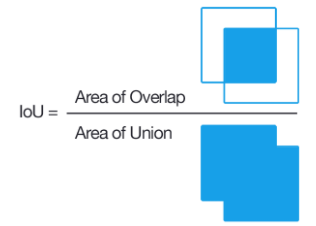
def bbox_iou(bbox_a, bbox_b): if bbox_a.shape[1] != 4 or bbox_b.shape[1] != 4: print(bbox_a, bbox_b) raise IndexError tl = np.maximum(bbox_a[:, None, :2], bbox_b[:, :2]) br = np.minimum(bbox_a[:, None, 2:], bbox_b[:, 2:]) area_i = np.prod(br - tl, axis=2) * (tl < br).all(axis=2) area_a = np.prod(bbox_a[:, 2:] - bbox_a[:, :2], axis=1) area_b = np.prod(bbox_b[:, 2:] - bbox_b[:, :2], axis=1) return area_i / (area_a[:, None] + area_b - area_i)
5.2 计算AP
(1)获得预测结果
- 图片送入网络得到预测结果 roi_cls_locs, roi_scores, rois等
- 对建议框进行解码,获得预测框 [ top, left, bottom, right, score, predicted_class ]
- 预测结果写入txt
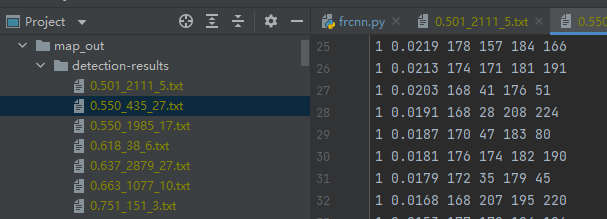
(2)获得真实框
- 从"VOC2007/Annotations/"+image_id+".xml"中找到xmin,ymin,xmax,ymax
- 写入txt
(3)按照置信度对预测框排序
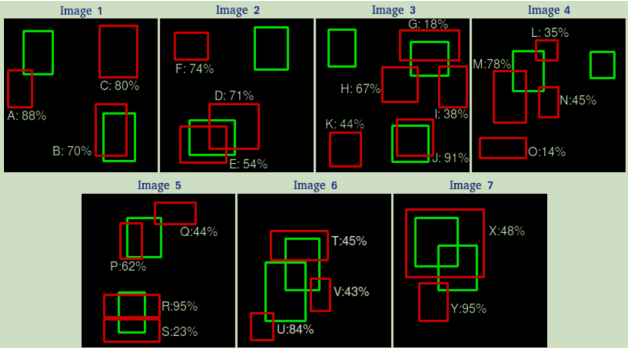
假设一共有7张图片,绿色框是GT(15个),红色框是预测框(24个)并带有置信度。
现在假设IOU=30%,按照置信度排序得到下表。

其中TP表示预测正确、FP表示预测错误、acc TP表示从头到该位置累计正确个数、precision表示从头到该位置的精确率、recall表示从头到该位置的召回率。
下图表示的就是从头到尾,依次加入新的样本时,P和R的变化情况:
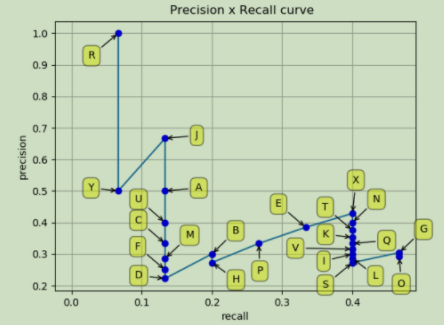
代码:
- 按照置信度排序
bounding_boxes.sort(key=lambda x:float(x['confidence']), reverse=True)
- 遍历bounding_boxes,计算IOU,大于min_overlap为TP,不然为FP
- 计算precision和recall
for idx, val in enumerate(tp): rec[idx] = float(tp[idx])/np.maximum(gt_counter_per_class[class_name], 1) # rec=tp/(tp+fn) # gt_counter_per_class 计算每个类有多少个gt,gt的个数=tp+fn for idx, val in enumerate(tp): prec[idx] = float(tp[idx]) / np.maximum((fp[idx] + tp[idx]), 1) # prec=tp/(tp+fp)
(4)使精度单调下降,计算PR曲线的面积
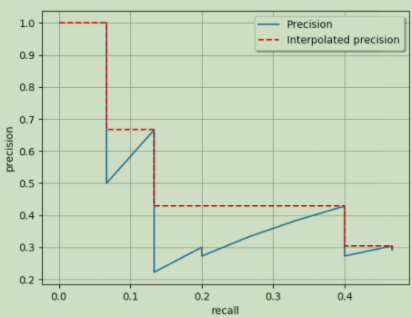
蓝色线就是前面那张PR图,红色虚线的纵坐标是单调减小的,每次减小到右侧蓝线的最高点。APall就是红色虚线下方的面积。
def voc_ap(rec, prec): rec.insert(0, 0.0) # insert 0.0 at begining of list rec.append(1.0) # insert 1.0 at end of list mrec = rec[:] prec.insert(0, 0.0) # insert 0.0 at begining of list prec.append(0.0) # insert 0.0 at end of list mpre = prec[:] # 1. 这一部分使精度单调下降 i_list = [] for i in range(1, len(mrec)): if mrec[i] != mrec[i-1]: i_list.append(i) # if it was matlab would be i + 1 # 2. 平均精度(AP)是曲线下的面积 ap = 0.0 for i in i_list: ap += ((mrec[i]-mrec[i-1])*mpre[i]) return ap, mrec, mpre
5.3 mAP指标
如果是多类别目标检测任务,就要使用mean AP(mAP),其定义为:

即,对所有的类别进行AP的计算,然后取均值。
AP50指的是IOU的值取50%,AP70同理。
AP@50:5:95指的是IOU的值从50%取到95%,步长为5%,然后算在在这些IOU下的AP的均值。
参考文献:
1. 目标检测01:常用评价指标(AP、AP50、AP@50:5:95、mAP)
3. Pytorch 搭建自己的Faster-RCNN目标检测平台(视频)
4. 深度学习小技巧-mAP精度概念详解与计算绘制 (视频)




【推荐】国内首个AI IDE,深度理解中文开发场景,立即下载体验Trae
【推荐】编程新体验,更懂你的AI,立即体验豆包MarsCode编程助手
【推荐】抖音旗下AI助手豆包,你的智能百科全书,全免费不限次数
【推荐】轻量又高性能的 SSH 工具 IShell:AI 加持,快人一步
· winform 绘制太阳,地球,月球 运作规律
· AI与.NET技术实操系列(五):向量存储与相似性搜索在 .NET 中的实现
· 超详细:普通电脑也行Windows部署deepseek R1训练数据并当服务器共享给他人
· 【硬核科普】Trae如何「偷看」你的代码?零基础破解AI编程运行原理
· 上周热点回顾(3.3-3.9)